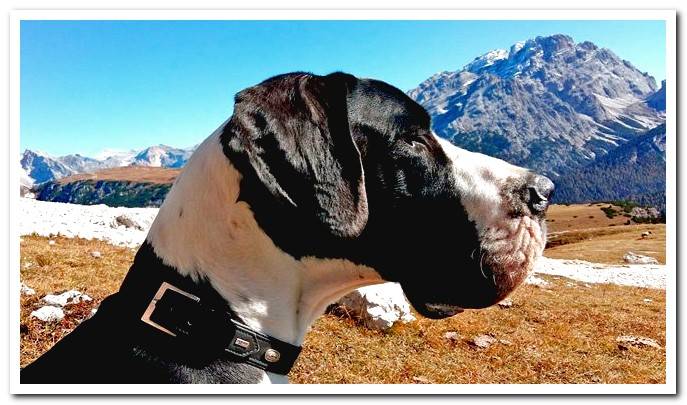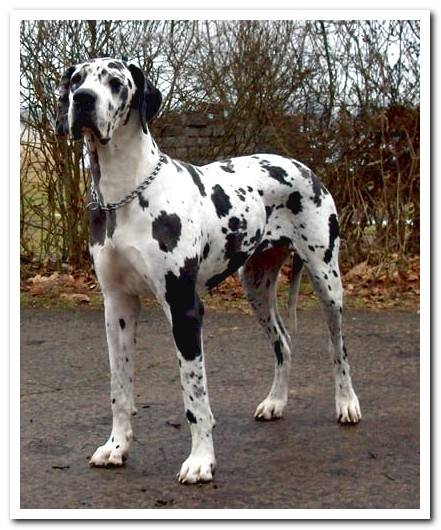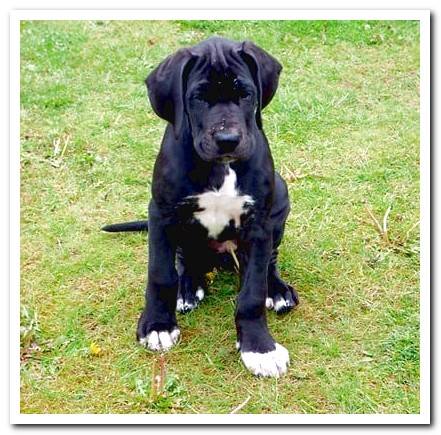
For some, the Great Dane represents the largest lap dog in the world. Do not be conditioned by its majestic bearing. This canid is big in dimensions but also in sweetness.
If you want to discover why, as well as what are its most recurring diseases, its care and other of its peculiarities, read this complete guide on Great Dane.
Index of contents
- 1 Technical data of the Great Dane breed
- 2 A bit of history about the Great Dane breed
- 3 Physical characteristics of the Great Dane dog
- 4 Great Dane dog breed temperament
- 5 Recommended care
- 6 Training: Basic notions
- 7 Possible diseases of the Great Dane dog
Technical data of the Great Dane breed
|
|
Height of between 90 and 90 cm in males and between 72 and 84 cm in females |
|
|
Weight between 75 and 100 kg for males and between 50 and 90 kg for females |
|
|
Very short, soft and straight hair. Black, white or mottled |
|
|
Cheerful, playful, loving and very loyal character |
|
|
Good health but prone to dysplasia and / or heart problems |
|
|
Estimated life expectancy between 9 and 12 years |
A bit of history about the Great Dane breed
Its origin is in Germany, so it is not known exactly why it is called Great Dane. It comes from the Bullenbeisser, a German breed, already extinct, halfway between the Whippet and the English Mastiff.
According to the chronology of its history it is known that the Alanos warriors were expelled from Asia and when they arrived in Europe they made crosses between their huge combat dogs and the German and French dog breeds.
As a result of these confluences in 1870 the Great Dane was born, a breed historically highly appreciated by kings, nobles and artists.
Did you know that the poet Alexander Pope had a copy of this breed as a pet? Its elegance, intelligence, fidelity and calm temperament are its most outstanding attributes.
In fact, he is considered the Apollo of all races, since he combines an imposing bearing and a delicate and affectionate personality, constituting a faithful companion of life.
However, in its origins it did not enjoy such an affable character. On the contrary, his instinct was that of a hunter, always combative.
For this reason, he was a regular in wild boar hunting. Successive breeding and training programs have successfully tamed him up to make him the loving and familiar can that is nowadays.
It receives other names such as German Bulldog, German Mastiff or German Alano and its life expectancy ranges from 7 to 10 years. Its proportions are great, as we will see below.
Physical characteristics of the Great Dane dog
Do you know that standing on its hind legs can reach 2.10 meters in height? Quite a giant if we refer to dogs.
In general, the females reach 72-84 cm in height and 50-90 kg in weight, while the males are about 80-90 cm in height and 75-100 kg in weight.
It is, therefore, a large breed but balanced and well proportioned. Qualities that have caused this breed Hold the Guinness record for the tallest dog and heavy of the world in various editions.
According to the International Cynological Federation, the FCI, the purity of the breed is certified if its length equals its height at the withers, not exceeding 5% in males and 10% in the case of females.

Likewise, you must meet these standards:
- Your neck should be long, strong, and slightly arched forward. The skin should not hang in the form of a double chin.
- Your back should draw a short straight line with a subtle backward fall.
- Its tail should be high and wide, tapering towards the tip. At rest it must simulate a natural curve while in movement it must be carried in the form of a saber.
- The lips must have well defined edges and the jaw must be equipped with powerful jaws, with a healthy bite.
- The legs should be parallel and the nose narrow.
- The cheek muscles should not protrude.
- Its head should be long and thin, but not pointed.
- Its ears are medium in size, high set and drooping. Formerly, there was a custom of cutting them to increase their solemnity, something that fortunately is no longer practiced today.
- Her hair is short, flattened, shiny and straight.
There are different shades for your hair:
- Tawny. It is characterized by its golden tone, soft or intense, accompanied by a black mask on the muzzle.
- Tabby. In this case the gold has black stripes in the area of the ribs. There is also the dark mask on the muzzle.
- Harlequin. We found different variants, from pure white, to white with black mottling or irregular jet black spots randomly distributed throughout its body.
- Black. Jet black is combined with white markings on the chest, muzzle, neck, belly, limbs, or tip of the tail.
- Blue. Dark steel blue is complemented by white markings on the chest and lower legs.
As a curiosity, it should be noted that in the blue and harlequin shades, the nose is anthracite or diluted black. In the harlequin also, it can be pink.
The eyes of the German Bulldog are almond-shaped, dark in color and must not be too far apart. In the blue and harlequin shades they may be lighter, with harlequins prone to heterochromia (one eye of each color).

Great Dane dog breed temperament
To its commented elegance and regal bearing, we must add a deep feeling of loyalty to its owner, it needs its company and it becomes a destroyer if it is bored or stays alone for a long time. Enjoy living with other dogs, with other pets and with children.
He is an intelligent dog, since in case he is disturbed he prefers to withdraw before falling into provocation.
Due to its large size, it requires large spaces, but it is not well adapted to living entirely outdoors. He prefers to do it indoors and exercise with its owner.
Recommended care
In terms of care, the Great Dane needs a large diet, especially when it is a puppy, a stage in which you must procure 3 meals a day, since it will reach 14 kilos in just 2 months.
As an adult, 2 meals of dry feed specific for large breeds will suffice, as well as supplements to safeguard the good condition of your joints and mitigate the reach of their considerable weight.
You will need to brush it 2 or 3 times a week to remove dead hair and dirt. This frequency could increase during the molting season (spring and autumn). Don’t abuse the toilets It could cause irritation, allergies or dry skin. Just doing it once a month is enough.
Given its propensity to accumulate tartar and bacteria, responsible for dental pathologies in the gums and bad breath, you should brush your teeth several times a day.
As an additional measure, dental snacks and sheets of cowhide are not superfluous. While you enjoy biting, your pet will strengthen its jaw thanks to its high contribution of vitamins and minerals and will eliminate possible tartar.
The Great Dane demands moderate exercise daily, about 30 or 60 minutes. Puppies require a little more activity, about 90 minutes a day. It helps them exercise and learn as they explore.
Keep your veterinary visit calendar updated and protect you from parasites with the deworming pills, pipettes and necklaces that your specialist recommends.
Training: Basic notions
Given its tendency to distance itself from strangers, a property that makes them the best breed as a guard dog, it is convenient that if you incorporate a specimen of this breed into your life you socialize it as a puppy so that it becomes habituated to humans.
The training of the drawer is appropriate for you to internalize as a puppy what confinement means. In this sense, you must provide him with a large basket so that he understands that it is the place where he should sleep.
Positive reinforcement through praise and rewards is ideal for training this breed. You can also practice it when you go to the vet so that this experience pleases you and is not scared.
Remember that until 2 years old your bone structure is not in the established tone and, therefore, it is not advisable to go running with it.
Possible diseases of the Great Dane dog
This breed has a certain genetic predisposition to suffer the following pathologies:
- Hip dysplasia.
- Gastric torsion. This is a common condition in large dogs and involves strangling their stomach. To prevent it, avoid large meals, it is preferable that you distribute them throughout the day. Give him the rest he needs after eating and don’t offer him food and water before or after physical exercise.
- Cardiomyopathy.
- Osteosarcoma or bone cancer.
- Wobbler syndrome. This neurological disease is hereditary and causes the dog to wobble when walking as a consequence of the narrowing of the spinal cord.
- Waterfalls.
- Entropion and ectopion. They are two eye injuries that cause irritation in the eyeball of the dog due to a bad position of the eyelid.
- Hypothyroidism
- Youth spots.
In all of them, surgery and / or pharmacological treatment have a good prognosis. Anyway, it does not hurt to remember that before any abnormality or strange change you should go to the vet.
Now you know that the race to which Scooby-Doo or Astro of the Jetsons belong has the ideal qualities for you to opt for it as your new pet. He will enjoy your company and that of your family, he will avoid bothering you at all costs and will know how to show you how much he loves you.
